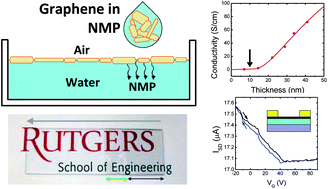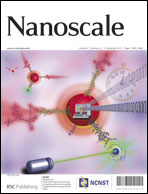Optoelectronic properties of graphene thin films deposited by a Langmuir–Blodgett assembly†
Abstract
Large area thin films of few-layered unfunctionalized graphene platelets are developed with fine control over the thickness. The thin films are obtained by a Langmuir–Blodgett assembly at the interface of graphene solution in N-methyl-2-pyrrolidone (NMP) and water, and their optoelectronic properties and conduction mechanism are investigated in relation to lateral flake size and thin film thickness. The electrical conductivity and carrier mobility are affected by the flake size (200 nm to 1 μm) and by the packing of the nanostructure platelet network. General effective medium theory is used to explain the thickness dependent conductivity and to determine the percolation threshold film thickness which was found to be about 10 nm (at a volume fraction of ∼39%) for a Langmuir–Blodgett film of an average platelet lateral size of 170 ± 40 nm. The electronic behaviour of the material shows more similarities with polycrystalline turbostratic graphite than thin films of reduced graphene oxide, carbon nanotubes, or disordered conducting polymers. While in these systems the conduction mechanism is often dominated by the presence of an energy barrier between conductive and non-conductive regions in the network, in the exfoliated graphene networks the conduction mechanism can be explained by the simple two-band model which is characteristic of polycrystalline graphite.


 Please wait while we load your content...
Please wait while we load your content...